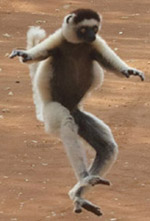Get
To Know
|
 Verreaux's Sifaka is a medium-sized lemur who lives in
Madagascar in a variety of habitats from rainforest to dry deciduous
forests of the west and the spiny thickets of the south. Fruit,
bark and flowers are typical components of the diet, but they eat
leaves much of the year. Their fur is thick and silky and generally
white with brown on the sides, top of the head, and on the arms.
They range between 42.5 and 45 cm and adult females reach 3.4 kg
on average, and adult males 3.6 kg. They have a long tail that they
use as a balance when leaping from tree to tree, but on the ground
their only means of locomotion is hopping. They are diurnal and
arboreal, and engage in sunbathing with outstretched arms and legs.
They move through the trees by clinging and leaping between vertical
supports. They live in family groups, or troops, of 2-12, which
may consist of one male and female, or many males and females together.
Group and population sex ratio can be more or less skewed toward
males although their society is matriarchal. They have a home range
of up to 5.0 hectares, and although they are territorial, they defend
food sources rather than territorial boundaries. Males and females
were found to engage in a biological market, exchanging grooming
for grooming during the non-mating period, and grooming for reproductive
opportunities during the mating period. Their play behavior persists
into adulthood where it is used, especially by stranger males during
the mating period, as an ice-breaking mechanism to reduce xenophobia.
Around 45% of females breed each year when in oestrous between late
January and early February and they give birth to one infant after
a gestation period of 130 days. For the first 6-8 weeks, the infant
clings to the mother's stomach, but for the following 19 weeks,
it clings to her back. About 30% of infants are lost to predation
by the Fossa and some to raptors like the Madagascar harrier-hawk.
Those who survive reach sexual maturity between 3-5 years. They
are listed as Critically Endangered in 2020 and their numbers seemed
to be influenced by the proportion of large trees and the plant
species Allouadia procera. They are not in danger of imminent extinction,
but both severe droughts and an increased annual variation in rainfall
levels can depress the population growth rate.
Verreaux's Sifaka is a medium-sized lemur who lives in
Madagascar in a variety of habitats from rainforest to dry deciduous
forests of the west and the spiny thickets of the south. Fruit,
bark and flowers are typical components of the diet, but they eat
leaves much of the year. Their fur is thick and silky and generally
white with brown on the sides, top of the head, and on the arms.
They range between 42.5 and 45 cm and adult females reach 3.4 kg
on average, and adult males 3.6 kg. They have a long tail that they
use as a balance when leaping from tree to tree, but on the ground
their only means of locomotion is hopping. They are diurnal and
arboreal, and engage in sunbathing with outstretched arms and legs.
They move through the trees by clinging and leaping between vertical
supports. They live in family groups, or troops, of 2-12, which
may consist of one male and female, or many males and females together.
Group and population sex ratio can be more or less skewed toward
males although their society is matriarchal. They have a home range
of up to 5.0 hectares, and although they are territorial, they defend
food sources rather than territorial boundaries. Males and females
were found to engage in a biological market, exchanging grooming
for grooming during the non-mating period, and grooming for reproductive
opportunities during the mating period. Their play behavior persists
into adulthood where it is used, especially by stranger males during
the mating period, as an ice-breaking mechanism to reduce xenophobia.
Around 45% of females breed each year when in oestrous between late
January and early February and they give birth to one infant after
a gestation period of 130 days. For the first 6-8 weeks, the infant
clings to the mother's stomach, but for the following 19 weeks,
it clings to her back. About 30% of infants are lost to predation
by the Fossa and some to raptors like the Madagascar harrier-hawk.
Those who survive reach sexual maturity between 3-5 years. They
are listed as Critically Endangered in 2020 and their numbers seemed
to be influenced by the proportion of large trees and the plant
species Allouadia procera. They are not in danger of imminent extinction,
but both severe droughts and an increased annual variation in rainfall
levels can depress the population growth rate.
|
|
|
|
On Safari with Hemmingway
by
Jeffrey Zable
I said to him, "Ernie, you told me we'd only
be observing the wildlife. I love animals
and killing them for sport goes against my nature."
"What kind of man are you!" he snarled in response.
"We're here for the thrill of the hunt!"
Unfortunately, because I was completely dependent on him
to get me out of there alive, I took the rifle from him and
said,
"After you! For the thrill of the hunt. For the thrill of the
hunt. . ."
Jeffrey Zable is a teacher, conga drummer/percussionist who plays for
dance classes and rumbas around the San Francisco Bay Area, and a writer
of poetry, flash-fiction, and non-fiction. He’s published five chapbooks
and his writing has appeared in hundreds of literary magazines and anthologies,
more recently in Chewers & Masticadores, Linked Verse, Ranger, Cacti
Fur, Uppagus, Greensilk, Alba, Poem Alone, and many others. . .
|
 Verreaux's
Sifaka - Issue Forty-Eight
Verreaux's
Sifaka - Issue Forty-Eight